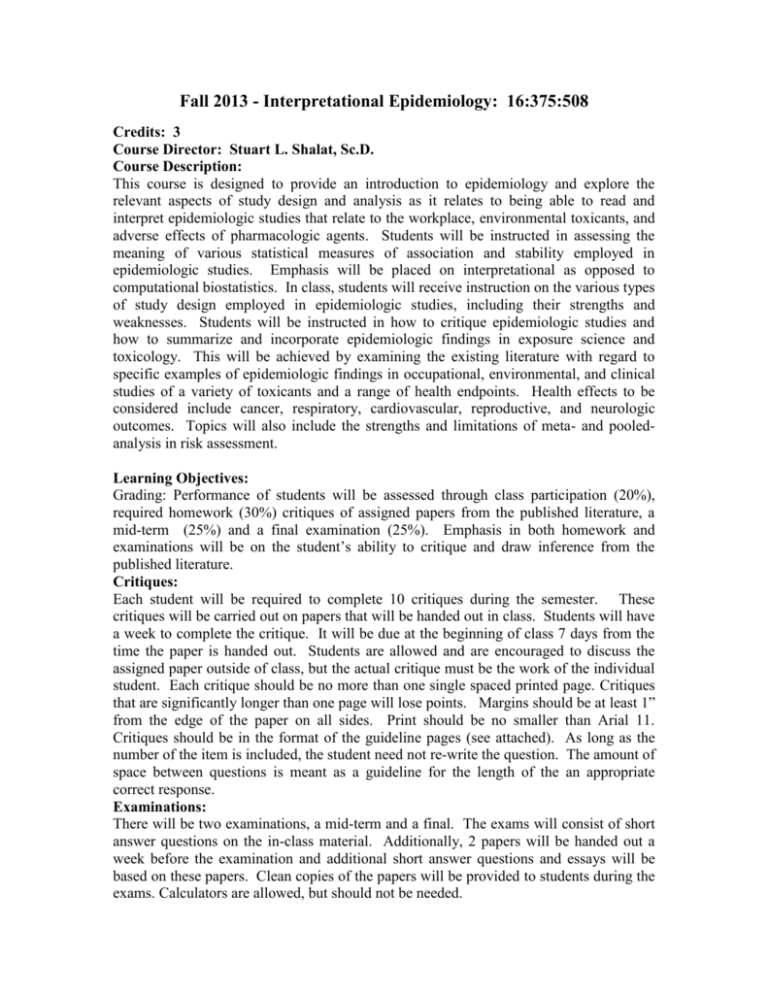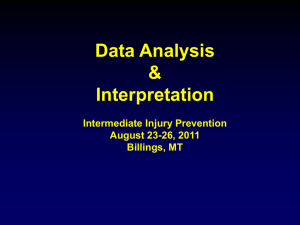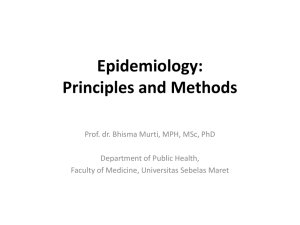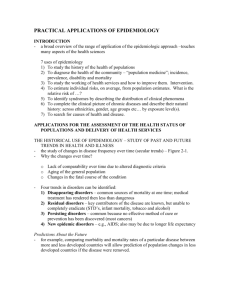Interpretational Epidemiology (3)-Shalat
advertisement

Fall 2013 - Interpretational Epidemiology: 16:375:508 Credits: 3 Course Director: Stuart L. Shalat, Sc.D. Course Description: This course is designed to provide an introduction to epidemiology and explore the relevant aspects of study design and analysis as it relates to being able to read and interpret epidemiologic studies that relate to the workplace, environmental toxicants, and adverse effects of pharmacologic agents. Students will be instructed in assessing the meaning of various statistical measures of association and stability employed in epidemiologic studies. Emphasis will be placed on interpretational as opposed to computational biostatistics. In class, students will receive instruction on the various types of study design employed in epidemiologic studies, including their strengths and weaknesses. Students will be instructed in how to critique epidemiologic studies and how to summarize and incorporate epidemiologic findings in exposure science and toxicology. This will be achieved by examining the existing literature with regard to specific examples of epidemiologic findings in occupational, environmental, and clinical studies of a variety of toxicants and a range of health endpoints. Health effects to be considered include cancer, respiratory, cardiovascular, reproductive, and neurologic outcomes. Topics will also include the strengths and limitations of meta- and pooledanalysis in risk assessment. Learning Objectives: Grading: Performance of students will be assessed through class participation (20%), required homework (30%) critiques of assigned papers from the published literature, a mid-term (25%) and a final examination (25%). Emphasis in both homework and examinations will be on the student’s ability to critique and draw inference from the published literature. Critiques: Each student will be required to complete 10 critiques during the semester. These critiques will be carried out on papers that will be handed out in class. Students will have a week to complete the critique. It will be due at the beginning of class 7 days from the time the paper is handed out. Students are allowed and are encouraged to discuss the assigned paper outside of class, but the actual critique must be the work of the individual student. Each critique should be no more than one single spaced printed page. Critiques that are significantly longer than one page will lose points. Margins should be at least 1” from the edge of the paper on all sides. Print should be no smaller than Arial 11. Critiques should be in the format of the guideline pages (see attached). As long as the number of the item is included, the student need not re-write the question. The amount of space between questions is meant as a guideline for the length of the an appropriate correct response. Examinations: There will be two examinations, a mid-term and a final. The exams will consist of short answer questions on the in-class material. Additionally, 2 papers will be handed out a week before the examination and additional short answer questions and essays will be based on these papers. Clean copies of the papers will be provided to students during the exams. Calculators are allowed, but should not be needed. Interpretational Epidemiology Course Syllabus Stuart L. Shalat, Sc.D. Associate Professor Office: EOHSI Building, Room 320 Email: shalat@eohsi.rutgers.edu Telephone: (848) 445-1295 Dates Lecture Topics 9/3 1) Introduction i. ii. iii. iv. 9/4 2) Understanding study design and statistical analysis in epidemiologic studies i. ii. iii. iv. v. 9/10 Why should you care? Exposure Science, Toxicology and Epidemiology. Role of epidemiology in risk assessment Traditional risk assessment Evaluating epidemiological literature for causality Randomized control trials Observational studies Prospective and retrospective studies Case control, cohort and nested case control Measures of association 3) Measures of Association and Stability i. ii. iii. iv. Incidence and prevalence Risk estimates: RR, OR, HR Confidence intervals and p values Role of time 9/11 4) Bias in Epidemiologic Studies i. Selection bias ii. Observation bias 9/17 5) Bias and Study Design i. Confounding Bias ii. Effect Modifiers iii. Types of Observational Epidemiologic Studies 1. 2. 3. 4. cross-sectional case-control retrospective cohort prospective cohort iv. Examining quality of data v. Study Validity vi. Generalizability 9/18 6) Clinical Trials i. ii. iii. iv. 9/24 7) Genetic Epidemiology i. ii. iii. iv. v. vi. 9/25 Disease characteristics Familial clustering Genetic or environmental, that is the question Mode of inheritance Disease susceptibility loci Disease susceptibility markers 8) SNPs, Gene expression and what does it all mean? i. ii. iii. iv. v. vi. 10/1 Experimental Studies Randomization Intention-to-treat analysis Dealing with lost to follow-up 9) SNPs DNA a. Base pairs b. Codons c. Amino acids What do proteins do? a. Code for antibodies b. Enzymes c. Structural proteins d. Messengers (i.e. hormones) e. Transport/Storage Gene Expression Analysis SNPs and Expression Studies Epigenetics Critiquing the Literature i. ii. iii. Type of Study Size Collection of data 10/2 10) Critiquing the Literature (Part 2) i. ii. 10/8 11) The Study of Respiratory Illnesses – Introduction i. ii. 10/9 12) Analysis of data Interpretation of study findings Objective measures - Pulmonary function tests Symptom questionnaires Discussion of Respiratory Disease Paper (Tegethoff, et al. 2013) 10/15 13) Meta-analysis, pooled- analysis and systematic reviews 10/16 Review for Mid-Term Exam 10/22 Mid-Term Exam 10/23 14) Pesticides i. Organochlorines ii. Organophosphates iii. Pyrethroids 10/29 15) 10/30 16) Discussion of Pesticide Papers The study of reproductive outcomes - Thalidomide and Birth Defects and reproductive outcomes. i. Selection bias in sampling from fertility clinics ii. Adverse pregnancy outcomes (miscarriages, stillbirth, low birth weight, congenital malformations) iii. Measurement error in pregnancy 11/5 17) Arsenic, Toxic Torts and Neural Tube Defects 11/6 18) Epidemiology and Children’s Studies i. Diagnostic challenges ii. Exposures 11/12 19) The Vaccine and Autism Controversy 11/13 20) Plasticizer Peril? The case against BPA and Pthalates. 11/19 21) DDT Revisited: Did Rachel Carson get it right? 11/20 22) Hazards in the Workplace and Occupational Epidemiology 11/26 NO CLASS THANKSGIVING WEEK SCHEDULE 11/27 NO CLASS THANKSGIVING WEEK SCHEDULE 12/3 23) The study of cardiovascular disease - When treatment goes wrong, the case of Vioxx. 12/4 24) Epidemiology of Disasters 12/10 25) MTBE: Did EPA and Congress get it wrong? 12/11 REVIEW FOR FINAL EXAMINATION Interpretational Epidemiology: 16:375:508 Study Critique Form Name: Title of Paper: 1. What was the study’s hypothesis(es)? Collection of Data 2. What type of study was done? 3. How was the size of the study determined? 4. How were study subject’s selected and would this have tended to introduce any selection bias? 5. How was information collected on the study subjects and could this have introduced any observation bias? 6. How was confounding bias dealt with in the study design and was it effective? Analysis of Data 1. Describe and criticize the methods used to control for confounding bias in the study analysis (i.e. stratification of data, multivariate analysis, etc.). 2. Describe and criticize the methods used for the measure of association between disease and exposure. 3. Describe and criticize the methods used to provide the measure of stability of the measures of association between disease and exposure. Interpretation of the Data 1. What was the major finding of the study? 2. How might any scientific biases (i.e. selection, observation, confounding) have affected the study’s finding? 3. Other than biasing the overall study results toward the null, how might random misclassification have affected the results? 4. To what population may the results of this study be generalized? 5. Are the author’s conclusions supported by the study’s results? 6. Do you believe the results (why or why not?)





